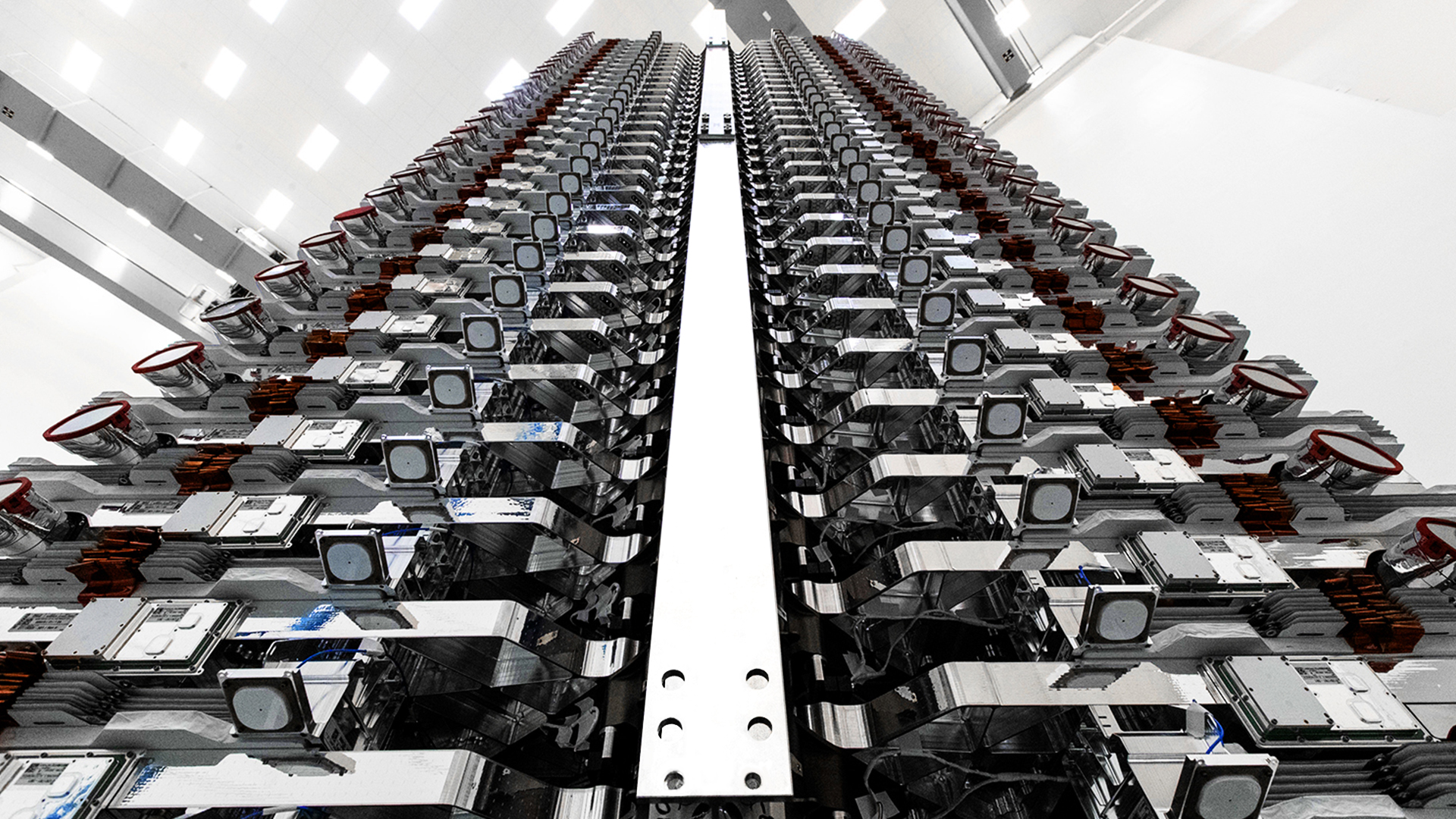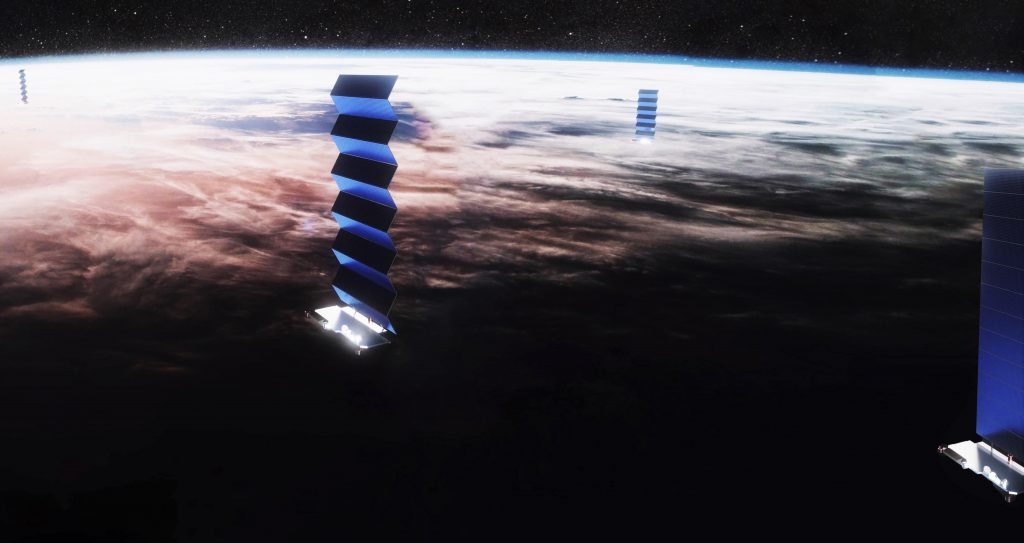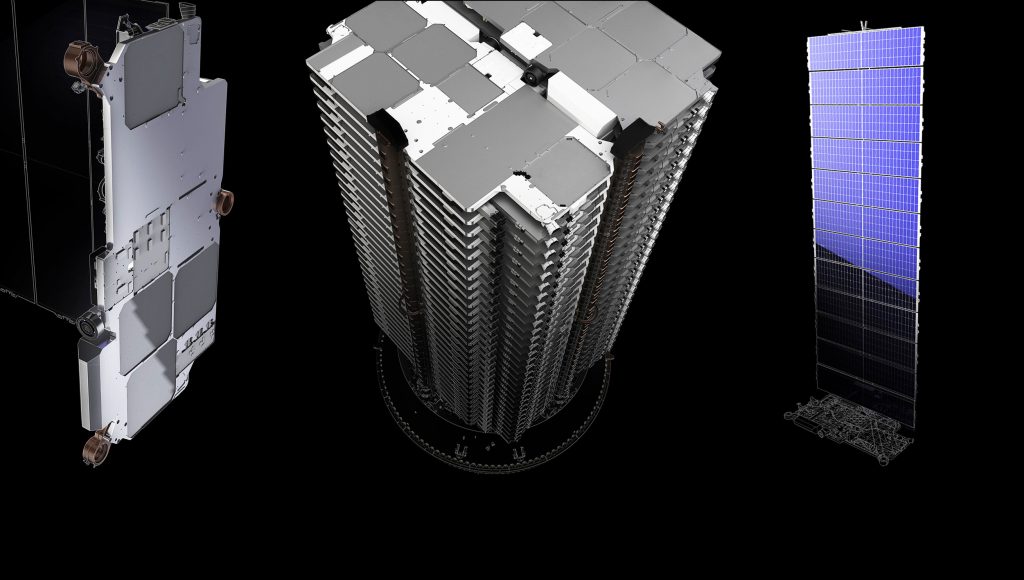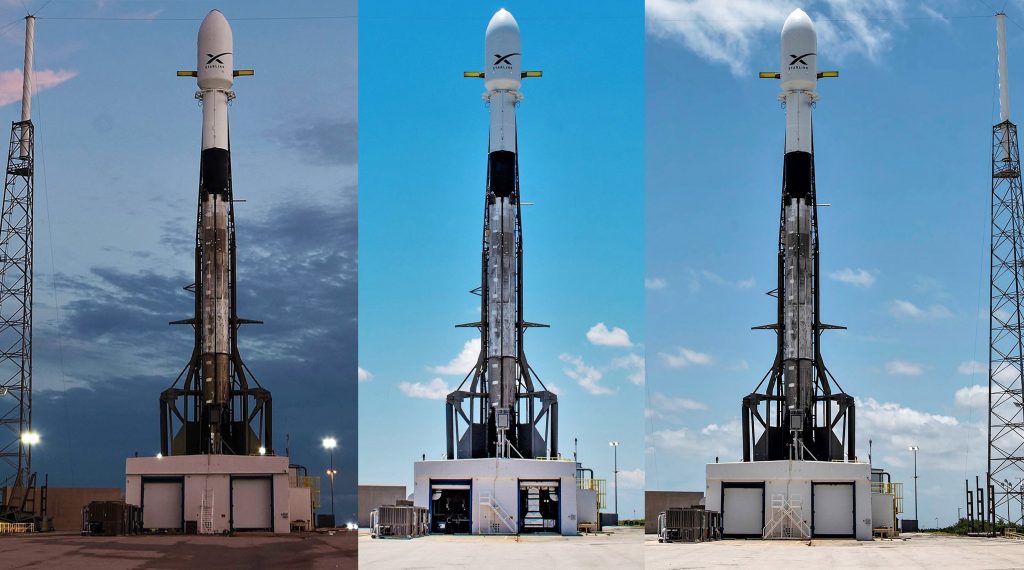

News
SpaceX planning four more Falcon 9-launched Starlink missions this year, permits show
According to a suite of eight FCC Special Temporary Authority licenses SpaceX filed for on August 30th, the company has plans for as many as four additional Starlink satellite launches in 2019, on top of Starlink’s May 23rd launch debut.
Additionally, SpaceX simultaneously requested that the FCC modify its current Starlink application to permit a slight change in orbital characteristics that would drastically improve the broadband satellite constellation’s coverage in its early stages. Combined, SpaceX appears to be extremely confident about the status and near-future progress to be made by its prospective Starlink constellation, confidence presumably inspired by the performance of the first 60 “v0.9” satellites launched three months ago.
Beta-test hiccups
Over the last three months, 50 of the 60 Starlink satellites launched on May 23rd have made their way to their final ~550 km (340 mi) circular orbits. As observed by astronomer Jonathan McDowell and partially confirmed by SpaceX’s own official statements, the company remains in contact with and – more or less – in control of all but three of the 60 Starlink prototypes. SpaceX did confirm in late June that two functioning satellites were being intentionally deorbited to test procedures and performance, while another three satellites had partially failed and were to “passively deorbit”.
And for completeness here is an updated version of the plot showing Starlink satellite height ((p+a)/2) versus time, no recent changes pic.twitter.com/E3a38afRse— Jonathan McDowell (@planet4589) August 28, 2019
Based on the phrasing of SpaceX’s June 28th update, it’s ambiguous if communication and/or control has been completely lost with those three satellites. Additionally, five more satellites have remained paused partway between their ~440 km insertion orbits and ~550 km operational orbits, described two months ago as “going through checkouts prior to completing their orbit raise.” For unknown reasons, that orbit raise never happened. This leaves SpaceX with 57 of 60 satellites that have effectively ‘survived’ and are still under some form of control, while 50 (83%) of the satellites have successfully reached their nominal operational orbits and are performing as intended.
SpaceX continues to waffle between describing these first 60 satellites – internally known as “Starlink v0.9” – as a development test and the first operational Starlink launch. A ~17% failure rate for satellite orbit raising would be unacceptable for a finished product but, on a positive note, is actually quite impressive if one assumes that the 60 spacecraft are high-fidelity prototypes, not operational satellites.

In short, there is a lot of room for improvement – particularly in the realm of short and long-term reliability – but the likely fact that “v0.9” signifies a sort of Starlink beta test means that SpaceX’s next Starlink launches will feature updated and bug-fixed hardware. In the realm of satellites, the practice of flying prototypes as early as possible and risking failures to learn from experience is exceedingly rare, but this behavior is entirely consistent with SpaceX’s preferred approach to rocket and spacecraft development.
300 satellites, 7 months
As mentioned above, SpaceX applied for four FCC STA licenses – effectively communications-related launch permits – on August 30th, all for Starlink missions with nominal No Earlier Than (NET) launch dates in 2019. It must be noted that it’s exceptionally rare for the starting dates of STAs to actually correlate with launch dates, but a best-case scenario typically sees a given launch occur within a handful of weeks of that date. STAs last six months, providing plenty of buffer for all but the most extreme launch delays.
| Mission | Date (NET) |
| Starlink-1 | October 10th |
| Starlink-2 | October 25th |
| Starlink-3 | November 13th |
| Starlink-4 | December 8th |
Of note, NASASpaceflight.com recently published Cape Canaveral Air Force Station (CCAFS) and Kennedy Space Center (KSC) planning dates for SpaceX’s next two Starlink missions, confirming that the company is planning for launches roughly one week after the dates on its newly-requested FCC STAs. Those official planning dates show two back-to-back Starlink launches no earlier than (NET) October 17th and November 4th.

In a best-case scenario where SpaceX successfully manufactures, delivers, and prepares the satellites and readies the Falcon 9 rockets assigned to launch them, the company could complete four more Starlink launches between now and the New Year. Sticking to a three-week cadence hopefully set by Starlink-1 and Starlink-2, two more launches could follow around late-November and mid-December. Of course, as just the first few truly operational launches of more or less finalized “v1.0” Starlink satellites, delays from manufacturing through launch flows are probable and should be expected.
Even completing just one more 60-satellite launch of an updated Starlink design would be an impressive achievement, making SpaceX the first and only entity – country or company – to place more than 100 satellites in orbit in the first year of a satellite system’s launch activities. In a best-case scenario, four additional Starlink launches in 2019 would abruptly take SpaceX from two satellite prototypes to operating almost 300 satellites – unequivocally the largest constellation in the world – in no more than seven months.

Serving customers sooner
According to SpaceX’s Starlink.com website, Starlink will be able to start serving customers at Northern US and southern Canadian latitudes after just six launches (360 satellites), with limited “global coverage of the populated world” available after 24 launches (1440 satellites). However, per an FCC license modification request published on August 30th, the same day as 8 launch STAs, the company believes it can dramatically expedite Starlink coverage (regardless of launch rate) with one relatively simple modification.
This modification would leave inclination (orbit angle relative to Earth’s rotational axis), orbital altitude, and the number of satellites and launches completely unchanged, modifying Starlink’s orbital planes instead. It’s an extreme simplification of the reality of orbital mechanics, but one can imagine orbital planes as roughly akin to lanes on a road. To increase their reach, SpaceX wants to deploy Starlink satellites to three separate planes each launch, ultimately tripling the number of ‘lanes’ (from 24 to 72) while cutting the number of satellites in each ‘lane’ by two-thirds (from 66 to 22). In this analogy, it is logically easier to build fewer ‘lanes’, referring – in this case – to the challenge it poses to the launch vehicle, satellites, or both. SpaceX would only be able to triple Starlink’s orbital ‘lanes’ by requiring the satellites to do the bulk of their own orbit raising, leaning heavily on the performance and reliability of their SpaceX-built electric (ion) propulsion.
According to SpaceX, this could as much as halve the number of launches needed to achieve a given level of Starlink coverage, meaning that SpaceX’s early constellation could reach its initial operational status up to twice as quickly. SpaceX believes that this updated orbital layout of Starlink’s 1584 low Earth orbit (LEO) satellites would also significantly improve coverage and capabilities for areas with high population density (i.e. big cities).
Whether or not the FCC sees fit to rapidly grant SpaceX’s modification request in the next ~8 weeks, SpaceX’s next Starlink launches will be a major step forward for the company’s nascent communications constellation.
Check out Teslarati’s Marketplace! We offer Tesla accessories, including for the Tesla Cybertruck and Tesla Model 3.
News
Tesla begins Robotaxi certification push in Arizona: report
Tesla seems serious about expanding its Robotaxi service to several states in the coming months.

Tesla has initiated discussions with Arizona transportation regulators to certify its driverless Robotaxi service in the state, as per a recent report from Bloomberg News. The move follows Tesla’s launch of its Robotaxi pilot program in Austin, Texas, as well as CEO Elon Musk’s recent comments about the service’s expansion in the Bay Area.
The Arizona Department of Transportation confirmed to Bloomberg that Tesla has reached out to begin the certification process for autonomous ride-sharing operations in the state. While details remain limited, the outreach suggests that Tesla is serious about expanding its driverless Robotaxi service to several territories in the coming months.
The Arizona development comes as Tesla prepares to expand its service area in Austin this weekend, as per CEO Elon Musk in a post on X. Musk also stated that Tesla is targeting the San Francisco Bay Area as its next major market, with a potential launch “in a month or two,” pending regulatory approvals.
Tesla first launched its autonomous ride-hailing program on June 22 in Austin with a small fleet of Model Y vehicles, accompanied by a Tesla employee in the passenger seat to monitor safety. While still classified as a test, Musk has said the program will expand to about 1,000 vehicles in the coming months. Tesla will later upgrade its Robotaxi fleet with the Cyercab, a two-seater that is designed without a steering wheel.
Sightings of Cybercab castings around the Giga Texas complex suggests that Tesla may be ramping the initial trial production of the self-driving two-seater. Tesla, for its part, has noted in the past that volume production of the Cybercab is expected to start sometime next year.
In California, Tesla has already applied for a transportation charter-party carrier permit from the state’s Public Utilities Commission. The company is reportedly taking a phased approach to operating in California, with the Robotaxi service starting with pre-arranged rides for employees in vehicles with safety drivers.
News
Tesla sets November 6 date for 2025 Annual Shareholder Meeting
The automaker announced the date on Thursday in a Form 8-K.

Tesla has scheduled its 2025 annual shareholder meeting for November 6, addressing investor concerns that the company was nearing a legal deadline to hold the event.
The automaker announced the date on Thursday in a Form 8-K submitted to the United States Securities and Exchange Commission (SEC). The company also listed a new proposal submission deadline of July 31 for items to be included in the proxy statement.
Tesla’s announcement followed calls from a group of 27 shareholders, including the leaders of large public pension funds, which urged Tesla’s board to formally set the meeting date, as noted in a report from The Wall Street Journal.
The group noted that under Texas law, where Tesla is now incorporated, companies must hold annual meetings within 13 months of the last one if requested by shareholders. Tesla’s previous annual shareholder meeting was held on June 13, 2024, which placed the July 13 deadline in focus.
Tesla originally stated in its 2024 annual report that it would file its proxy statement by the end of April. However, an amended filing on April 30 indicated that the Board of Directors had not yet finalized a meeting date, at least at the time.
The April filing also confirmed that Tesla’s board had formed a special committee to evaluate certain matters related to CEO Elon Musk’s compensation plan. Musk’s CEO performance award remains at the center of a lengthy legal dispute in Delaware, Tesla’s former state of incorporation.
Due to the aftermath of Musk’s legal dispute about his compensation plan in Delaware, he has not been paid for his work at Tesla for several years. Musk, for his part, has noted that he is more concerned about his voting stake in Tesla than his actual salary.
At last year’s annual meeting, TSLA shareholders voted to reapprove Elon Musk’s compensation plan and ratified Tesla’s decision to relocate its legal domicile from Delaware to Texas.
Elon Musk
Grok coming to Tesla vehicles next week “at the latest:” Elon Musk
Grok’s rollout to Tesla vehicles is expected to begin next week at the latest.

Elon Musk announced on Thursday that Grok, the large language model developed by his startup xAI, will soon be available in Tesla vehicles. Grok’s rollout to Tesla vehicles is expected to begin next week at the latest, further deepening the ties between the two Elon Musk-led companies.
Tesla–xAI synergy
Musk confirmed the news on X shortly after livestreaming the release of Grok 4, xAI’s latest large language model. “Grok is coming to Tesla vehicles very soon. Next week at the latest,” Musk wrote in a post on social media platform X.
During the livestream, Musk and several members of the xAI team highlighted several upgrades to Grok 4’s voice capabilities and performance metrics, positioning the LLM as competitive with top-tier models from OpenAI and Google.
The in-vehicle integration of Grok marks a new chapter in Tesla’s AI development. While Tesla has long relied on in-house systems for autonomous driving and energy optimization, Grok’s integration would introduce conversational AI directly into its vehicles’ user experience. This integration could potentially improve customer interaction inside Tesla vehicles.
xAI and Tesla’s collaborative footprint
Grok’s upcoming rollout to Tesla vehicles adds to a growing business relationship between Tesla and xAI. Earlier this year, Tesla disclosed that it generated $198.3 million in revenue from commercial, consulting, and support agreements with xAI, as noted in a report from Bloomberg News. A large portion of that amount, however, came from the sale of Megapack energy storage systems to the artificial intelligence startup.
In July 2023, Musk polled X users about whether Tesla should invest $5 billion in xAI. While no formal investment has been made so far, 68% of poll participants voted yes, and Musk has since stated that the idea would be discussed with Tesla’s board.
-

 Elon Musk1 week ago
Elon Musk1 week agoTesla investors will be shocked by Jim Cramer’s latest assessment
-

 Elon Musk18 hours ago
Elon Musk18 hours agoxAI launches Grok 4 with new $300/month SuperGrok Heavy subscription
-

 Elon Musk3 days ago
Elon Musk3 days agoElon Musk confirms Grok 4 launch on July 9 with livestream event
-

 News7 days ago
News7 days agoTesla Model 3 ranks as the safest new car in Europe for 2025, per Euro NCAP tests
-

 Elon Musk2 weeks ago
Elon Musk2 weeks agoA Tesla just delivered itself to a customer autonomously, Elon Musk confirms
-

 Elon Musk1 week ago
Elon Musk1 week agoxAI’s Memphis data center receives air permit despite community criticism
-

 Elon Musk2 weeks ago
Elon Musk2 weeks agoTesla’s Omead Afshar, known as Elon Musk’s right-hand man, leaves company: reports
-

 News2 weeks ago
News2 weeks agoXiaomi CEO congratulates Tesla on first FSD delivery: “We have to continue learning!”

















